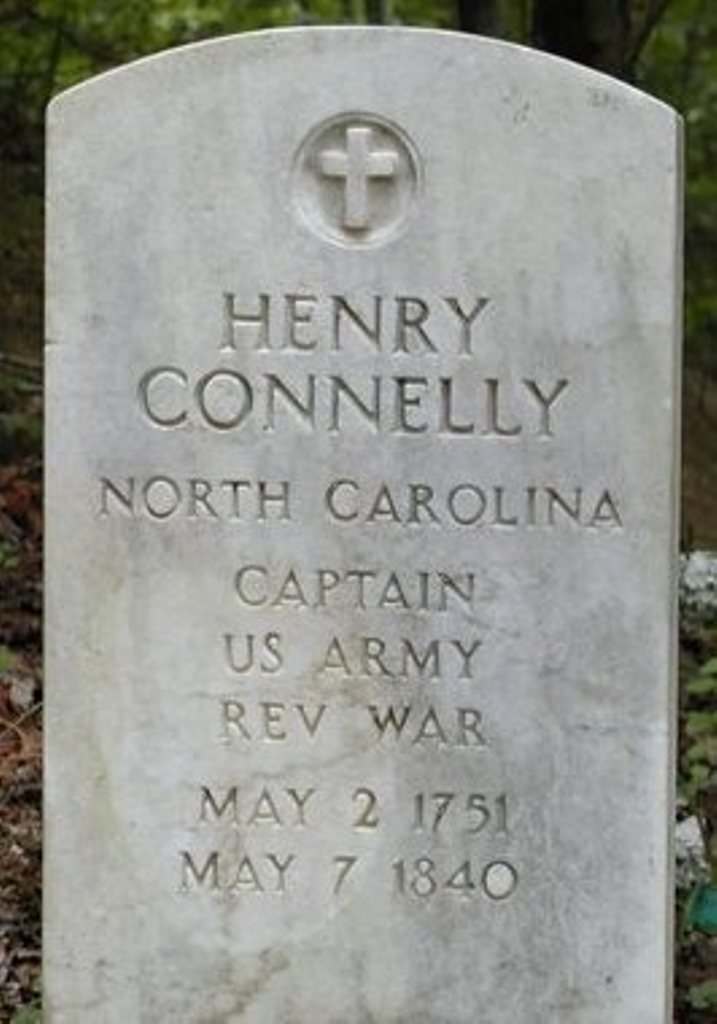Henry CONNELLY
SAR Patriot #:
P-137536
The following information was assembled from numerous sources and cannot be used directly as proof of Qualifying Service or Lineage.
It is considered a research aid and is intended to assist in locating sources that can be used as proof.
State of Service: NC
Qualifying Service: Captain
DAR #: A025047
Birth: 02 May 1752 / Chester / PA
Death: 07 May 1840 / Floyd / KY
Qualifying Service Description:
NSDAR cites CAPT, NC MILITIA, CAVALRY, COLs PAISLEY, JOHN WILLIAMS, JOHN TAYLOR, DAVIS, WILLIAM DAVIDSON, NC
Additional References:
- Pension Number S*W8188
- BLWT #30599-160-55
Spouse: (1) Ann MacGregor; (2) Temperance Hitchcock
Children: Rachel; Thomas; John; Elizabeth; Edmund; Henry; David
Members Who Share This Ancestor
| Date Approved | Society | ACN | SAR Member Info | Lineage via Child | View Application Detail | |
|---|---|---|---|---|---|---|
| 1976-08-19 | OH | Unassigned | Chester Eugene May (111339) | Thomas | ||
| 1984-02-28 | KY | Unassigned | James Darwin Stephens (123490) | Thomas | ||
| 1985-01-08 | VA | Unassigned | Bruce David May (125112) | Thomas | ||
| 1987-02-06 | VA | 225873 | Robert Paul May (128925) | Thomas | ||
| 1992-12-14 | VA | 211850 | David Durand May (139870) | Thomas | ||
| 1994-01-28 | OH | 209397 | Roger Eugene Bushatz (141869) | Thomas | ||
| 1994-01-28 | OH | 209398 | Paul Bushatz (141870) | Thomas | ||
| 1994-01-28 | OH | 209399 | George Aaron Bushatz (141871) | Thomas | ||
| 1994-08-30 | NC | 208001 | Mark Randall Conley (143109) | Edmund | ||
| 1997-01-24 | OH | 203020 | Elza May Jr (147548) | Thomas | ||
| 1997-07-17 | OH | 201212 | David May (148642) | Thomas | ||
| 1998-03-19 | OH | 568 | Marvin Lewis Spradlin (149997) | Rachel | ||
| 1999-06-22 | KS | 3953 | James Ellsworth Bond (138552) | John | ||
| 2009-08-19 | OH | 36290 | Homer Daniel May (174952) | Thomas | ||
| 2009-08-19 | OH | 36291 | John Russell May (174953) | Thomas | ||
| 2009-08-19 | OH | 36292 | David Ross May (174954) | Thomas | ||
| 2009-11-02 | FL | 36907 | Stephen Mark Conley (175376) | Thomas | ||
| 2013-04-18 | OH | 52716 | Ryan Dean Radabaugh II (185420) | John | ||
| 2014-09-24 | KY | 60198 | Larry Milford Leslie II (138905) | David | ||
| 2015-05-08 | CA | 63829 | Christopher Hollan Benbow (194592) | John | ||
| 2015-05-08 | CA | 63830 | Samuel Hollan Benbow (194593) | John | ||
| 2017-06-02 | KY | 75139 | Richard Thomas Salyer (202981) | Thomas | ||
| 2017-08-11 | NY | 76499 | Derek Matthew Brown (203979) | Thomas | ||
| 2017-12-31 | KY | 78824 | John Ray Conley (205819) | John | ||
| 2018-01-12 | IL | 78901 | Joshua Jay Conley (205931) | Thomas | ||
| 2019-09-06 | NC | 88244 | Timothy Martin Ratliff (212888) | Edmund | ||
| 2019-11-22 | IN | 89314 | Stephen Grant Walton (213802) | Thomas | ||
| 2020-08-13 | TN | 91679 | John Allen Carey Burdette (192745) | David | ||
| 2022-12-02 | OH | 104522 | Kenneth Dale Penn (224489) | Thomas | ||
| 2024-12-13 | TN | 114424 | Michael Henry May (232040) | Thomas | ||
| 2025-01-31 | OH | 115102 | Joshua Andrew May (232509) | Thomas | ||
| 2025-01-31 | OH | 115103 | Tanner Lee Hicks (232510) | Thomas | ||
| 2025-01-31 | OH | 115104 | Myles Christopher Hicks (232511) | Thomas |
Location:
Oil Springs / Johnson / KY / USA
Find A Grave Cemetery #:
Marker Type:
VA Vertical
SAR Grave Dedication Date:
Comments:
Directions to Cemetery / Gravesite:
